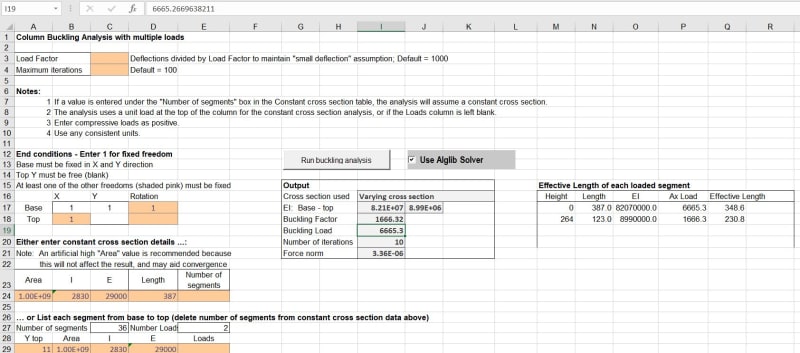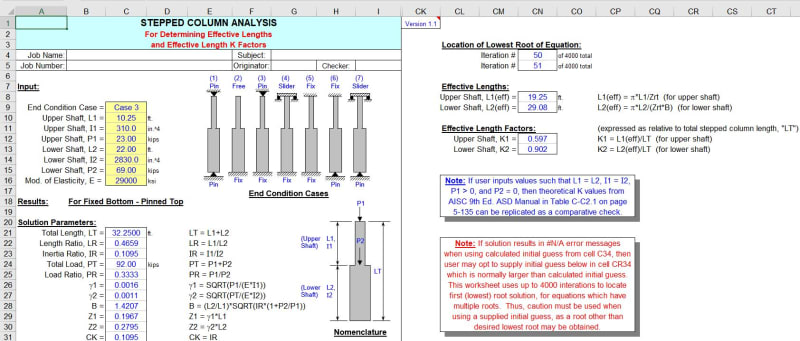-
1
- #1
Navigation
Install the app
How to install the app on iOS
Follow along with the video below to see how to install our site as a web app on your home screen.
Note: This feature may not be available in some browsers.
More options
You are using an out of date browser. It may not display this or other websites correctly.
You should upgrade or use an alternative browser.
You should upgrade or use an alternative browser.
multi load column buckling analysis 7
- Thread starter ozPE
- Start date
- Status
- Not open for further replies.
JoshPlumSE
Structural
Retired13 said:So far our understanding on this matter is so limited - multiple axial loads on a column (why's that?), and its not a step column. Can anybody name/suggest a correct solution/method/formulation at this time? I am out.
The AISC design guide on Tapered Members gives a method in one of their appendices called the "Method of Successive Approximations" that is actually very accurate for stepped or tapered members. One of the examples shown is a stepped column which has an axial load applied at the top and approximately halfway down (at the step). This method can be used effectively for an prismatic member that just has varying axial load along the length.
As PhamENG was saying, the methods for stepped columns can be used for these cases (varying load) as well.
All that being said, I agree with Retired13 in that the easiest way to start is to look at the total load and total unbraced length and start there. If that results in a reasonable design, there is no reason to go to the extra effort (which is significant) to do these other methods.
OP said:It is a welded T section with axial and single axis moment.
I guess the OP has moved onto his next assignment
- Thread starter
- #23
Retired13,
I am still here, refreshing this web every 5 min for all of your comments.
In my case as some of you pointed out the column was very small, 400mm high, 300 base width welded 14mm flange and stem plates. No laughing please. It is still a critical item, i designed it as a friction clamp that holds a timber post temporarly during renovation of a timber roof frame.
As i said before, it was perfectly ok for this application to be done with total load at top.
I still need to do some more research on the subject for future applications to be more economical in case the scale is larger plus it is a good practice to brush off some theory.
I am still here, refreshing this web every 5 min for all of your comments.
In my case as some of you pointed out the column was very small, 400mm high, 300 base width welded 14mm flange and stem plates. No laughing please. It is still a critical item, i designed it as a friction clamp that holds a timber post temporarly during renovation of a timber roof frame.
As i said before, it was perfectly ok for this application to be done with total load at top.
I still need to do some more research on the subject for future applications to be more economical in case the scale is larger plus it is a good practice to brush off some theory.
a bit off topic : for real stepped column (section variation along its length) using the total load with the total length we should consider the equivalent length as per attached doc
-
1
- #26
robyengIT - was the link in your latest post supposed to be the same as the one you posted previously?
For some reason the pdf file on the last sheet of that spreadsheet doesn't open on my machine; I only get the first page. The spreadsheet itself works though.
I found the same spreadsheet with a pdf that did open at:
I have also modified my column buckling spreadsheet to allow loads to be applied at any point along the column. I compared a couple of examples with the Stepcol spreadsheet and also linear buckling and non-linear geometry analyses in Strand7, and got very similar results in all cases.
I'll tidy up my spreadsheet a bit and post here.
Doug Jenkins
Interactive Design Services
For some reason the pdf file on the last sheet of that spreadsheet doesn't open on my machine; I only get the first page. The spreadsheet itself works though.
I found the same spreadsheet with a pdf that did open at:
I have also modified my column buckling spreadsheet to allow loads to be applied at any point along the column. I compared a couple of examples with the Stepcol spreadsheet and also linear buckling and non-linear geometry analyses in Strand7, and got very similar results in all cases.
I'll tidy up my spreadsheet a bit and post here.
Doug Jenkins
Interactive Design Services
IDS : sorry for mistake. Therefore I attach here the PDF
-
1
- #28
-
1
- #29
My buckling spreadsheet with multiple point loads can now be downloaded from:
The spreadsheet allows for any number of segments with different section properties and point loads.
My results for the example in the Stepcol spreadsheet are:

And the Stepcol results:

Doug Jenkins
Interactive Design Services
The spreadsheet allows for any number of segments with different section properties and point loads.
My results for the example in the Stepcol spreadsheet are:

And the Stepcol results:

Doug Jenkins
Interactive Design Services
See:
for more details of Frame4buckle-multiload spreadsheet.
Doug Jenkins
Interactive Design Services
for more details of Frame4buckle-multiload spreadsheet.
Doug Jenkins
Interactive Design Services
- Status
- Not open for further replies.
Similar threads
- Replies
- 18
- Views
- 39
- Locked
- Question
- Replies
- 6
- Views
- 20
- Replies
- 2
- Views
- 6
- Locked
- Question
- Replies
- 11
- Views
- 22
- Question
- Replies
- 4
- Views
- 26
